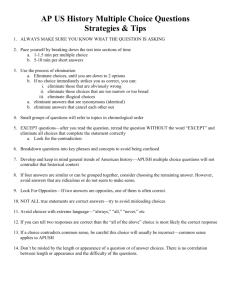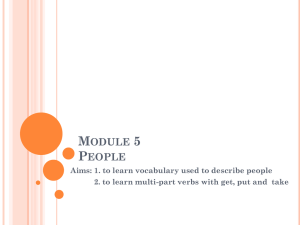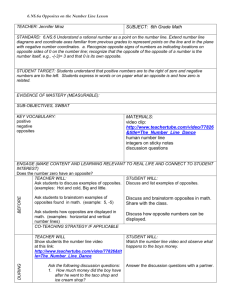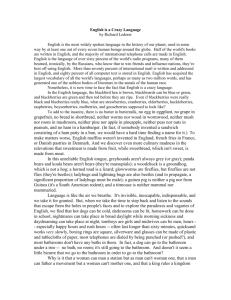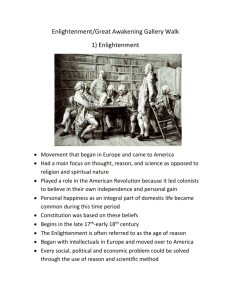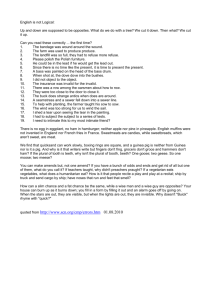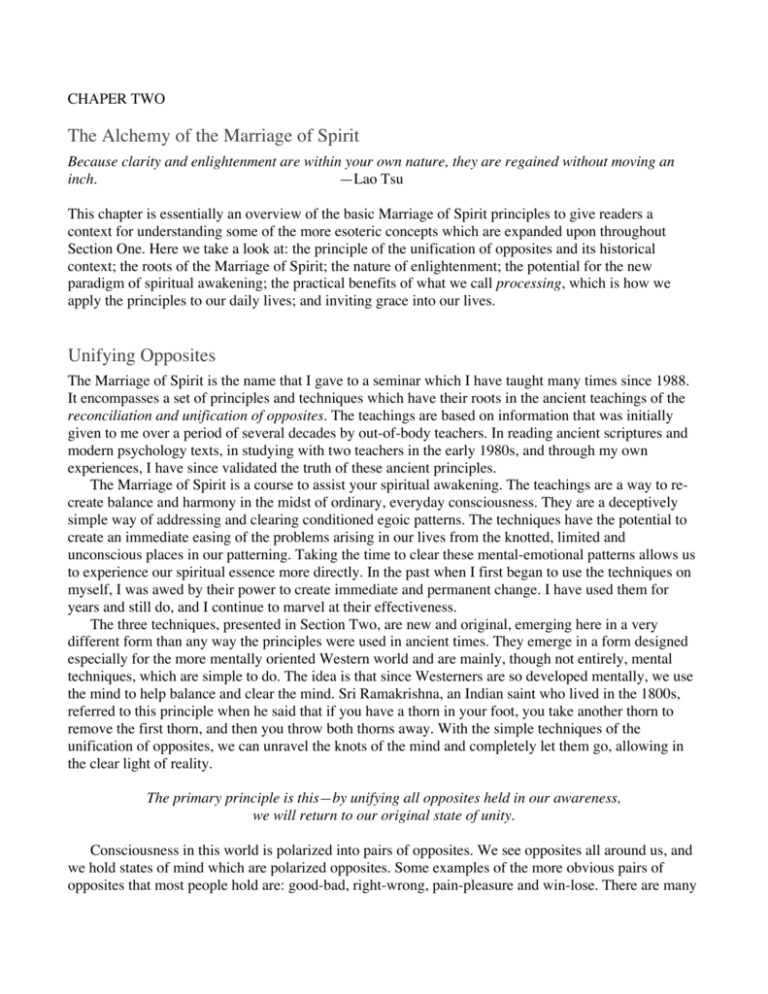
CHAPER TWO
The Alchemy of the Marriage of Spirit
Because clarity and enlightenment are within your own nature, they are regained without moving an
inch.
—Lao Tsu
This chapter is essentially an overview of the basic Marriage of Spirit principles to give readers a
context for understanding some of the more esoteric concepts which are expanded upon throughout
Section One. Here we take a look at: the principle of the unification of opposites and its historical
context; the roots of the Marriage of Spirit; the nature of enlightenment; the potential for the new
paradigm of spiritual awakening; the practical benefits of what we call processing, which is how we
apply the principles to our daily lives; and inviting grace into our lives.
Unifying Opposites
The Marriage of Spirit is the name that I gave to a seminar which I have taught many times since 1988.
It encompasses a set of principles and techniques which have their roots in the ancient teachings of the
reconciliation and unification of opposites. The teachings are based on information that was initially
given to me over a period of several decades by out-of-body teachers. In reading ancient scriptures and
modern psychology texts, in studying with two teachers in the early 1980s, and through my own
experiences, I have since validated the truth of these ancient principles.
The Marriage of Spirit is a course to assist your spiritual awakening. The teachings are a way to recreate balance and harmony in the midst of ordinary, everyday consciousness. They are a deceptively
simple way of addressing and clearing conditioned egoic patterns. The techniques have the potential to
create an immediate easing of the problems arising in our lives from the knotted, limited and
unconscious places in our patterning. Taking the time to clear these mental-emotional patterns allows us
to experience our spiritual essence more directly. In the past when I first began to use the techniques on
myself, I was awed by their power to create immediate and permanent change. I have used them for
years and still do, and I continue to marvel at their effectiveness.
The three techniques, presented in Section Two, are new and original, emerging here in a very
different form than any way the principles were used in ancient times. They emerge in a form designed
especially for the more mentally oriented Western world and are mainly, though not entirely, mental
techniques, which are simple to do. The idea is that since Westerners are so developed mentally, we use
the mind to help balance and clear the mind. Sri Ramakrishna, an Indian saint who lived in the 1800s,
referred to this principle when he said that if you have a thorn in your foot, you take another thorn to
remove the first thorn, and then you throw both thorns away. With the simple techniques of the
unification of opposites, we can unravel the knots of the mind and completely let them go, allowing in
the clear light of reality.
The primary principle is this—by unifying all opposites held in our awareness,
we will return to our original state of unity.
Consciousness in this world is polarized into pairs of opposites. We see opposites all around us, and
we hold states of mind which are polarized opposites. Some examples of the more obvious pairs of
opposites that most people hold are: good-bad, right-wrong, pain-pleasure and win-lose. There are many
more, as you will see in later chapters. It is possible to find the underlying unity inherent in all the pairs
of opposites within us. Finding this unity is an awakening to a more expanded state of consciousness and
to our spiritual essence. And that, with its many ramifications for our awareness, is what the techniques
are about.
Origin of the Unification of Opposites
The historic origin of this principle is still evident in various forms in a great number of different
religions and traditions—although it is more conspicuous in some than in others. Let’s take a look at a
few:
In the ancient Chinese Taoist tradition, the principle of opposites inherent in the teachings is
revealed very clearly in the diagram of the yin-yang symbol (Fig. 2-1). In this wonderfully explicit
symbol, the black and white sides wrap around each other in perfect balance, conveying the feeling of
the opposites belonging together as one unified whole contained within the circle of eternity. As Carl
Jung said, “When yang has reached its greatest strength, the dark power of yin is born within its depths.
For night begins at midday when yang breaks up and begins to change to yin.”
In Tantra, which means the balancing of opposites, the ideal of unity is symbolically expressed in
the union of Shiva and Shakti, being and manifestation, and masculine and feminine. In the traditional
practice of Tantric yoga, the unification of opposites is usually lived out in a physical way. Figure 2-2
symbolizes the manner in which the separations that exist within the physical realm are able to reunify
in gesture and action.
In the Bhagavad Gita, which is the primary scripture of Hinduism, Krishna speaks of the unification
of opposites to Arjuna. He says, “You must be free from the pairs of opposites. Poise your mind in
tranquility.”
In Buddhism, one of the principle tenets is that of the Middle Path. The Buddha advocated that
walking between the extremes of the pairs of opposites is the path to enlightenment, or Nirvana.
An example from Christian literature is in the Gnostic text, the Gospel According to Thomas,
discovered in 1945 in Nag Hamadi, Egypt, which is believed to have been produced in about ad 140.
“Jesus said to them: When you make the two one, and when you make the inner as the outer and the
outer as the inner and the above as the below, and when you make the male and the female into a single
one, so that the male will not be male and the female not be female… then shall you enter [the
Kingdom].”
Although the teachings of the Christian Bible do not emphasize the principle of the unification of
opposites, there are still references to it. One of the more explicit references is in Isaiah 11:6-10, which
implies that the knowledge of God comes when opposites are unified. “The wolf also shall dwell with
the lamb, and the leopard shall lie down with the young goat; and the calf and the young lion and the
fatling together; and a little child shall lead them. The cow and the bear shall graze; their young ones
shall lie down together; and the lion shall eat straw like the ox. The nursing child shall play by the
cobra’s hole, and the weaned child shall put his hand in the viper’s den.…For the earth shall be full of
the knowledge of the Lord, as the waters cover the sea.”
In fact, although all three major monotheistic religions—Christianity, Judaism and Islam—do not
emphasize the reconciliation of opposites, their belief in the one God over the many is in itself an
acknowledgement of God as the absolute state of unity.
The teaching of the unification of opposites is also clear in Islamic mysticism, or Sufism, and in
Jewish mysticism, or Kabbalah. As Sufi master Hazrat Inayat Khan is quoted in Universal Sufism:
“Mental purification means that impressions such as good and bad, wrong and right, gain and loss, and
pleasure and pain, these opposites which block the mind, must be cleared out by seeing the opposite of
these things. Then one can see the enemy in the friend and the friend in the enemy. When one can
recognize poison in nectar and nectar in the poison, that is the time when death and life become one, too.
Opposites no more remain opposites before one.”
As Daniel C. Matt states in The Essential Kabbalah in his discussion of absolute undifferentiation:
“At the deepest levels of divinity, all opposites and distinctions vanish, overwhelmed by oneness.”
In the context of modern psychology, Carl Jung wrote extensively about the unification of opposites.
For example: “Nothing can exist without its opposite; the two were one in the beginning and will be one
again in the end.” Also: “Therefore the perfected sage liberates himself from the opposites, having seen
through their connection with one another and their alternation.” Also: “The Ramayana says, ‘This
world must suffer under pairs of opposites for ever.’ Not to allow oneself to be influenced by the pairs of
opposites but…to raise oneself above them, is an essentially ethical task, because deliverance from the
opposites leads to redemption.”
If you find that you are getting curious about how this esoteric principle works in a practical sense,
you can begin reading the introduction to Section Two and Chapter Nine— Polarities, the first chapter
of Section Two, at any time. They present the first technique of the Marriage of Spirit teachings and
offer simple instruction in applying the unification of opposites to your daily life. I do recommend,
however, that you come back to Section One, the principles, to gain an understanding of how the
spiritual laws that support the techniques work.
Why Is It Called the Marriage of Spirit?
Marriage is the mystical and sacred blending of two different and seemingly opposite elements. The
principles contained in this book teach us about the underlying unity of spirit inherent in all of life.
Traditionally we think of marriage as an outward joining of two people, a man and a woman. In fact
during the marriage ceremony, the energies of the two partners are blended into one energy. Although
each of the individuals retains uniqueness as well, this creates at one level of the two individual people,
a new unified energy. This paradox of unity versus uniqueness is the great mystery of our spiritual
nature. The fusing of opposites is the alchemy of transformation.
The term marriage is also used with regard to the principles of this book to convey the full depth of
possibilities available for the unifying of our own inner masculine and feminine aspects. On the path to
awakening, this is what we must do. It is not just an integration, but an alchemic fusing together of all
the opposites that we hold in our minds. Focusing on creating unity and equality between the masculine,
feminine and all the other opposites within us is an essential part of the transformational work.
In enlightenment, too, this marriage happens. Our awareness is held in unity, and yet we retain our
individual uniqueness. Unity does not mean uniformity; the awakened mind has the ability to see unity
and yet also to live within the diversity of life. This paradigm is known as unity in diversity. The
principle of the whole being greater than the sum of its parts is a profound aspect of the mystery of the
spiritual life. It implies that as we reconcile all the opposites in our awareness, something new—a third
element, the background presence of unity—is born in us, beyond the dual states that we held when we
started the work. This is our awakening to the presence of unity. Paradoxically, unity is always present
with us; we are just too distracted by the complexity of life to see it. As we revisit this unified state, we
return to wholeness while living here in this amazing world.
The Marriage of Spirit in Context
The roots of the Marriage of Spirit lie in the important practice of self-inquiry, of looking within in order
to understand and to know ourselves. Self-inquiry is one of the many tools essential for true
transformation and enlightenment.
The Marriage of Spirit is a method born out of a synthesis of several disciplines, known for their
different ways of practicing self-inquiry, yet it has a completely different manifestation from its roots.
The method is born in many ways out of a mixture of: 1) Tantric yoga, the yoga of balancing opposites;
2) Jnana yoga, the yoga of the mind, or making the mind one with God; and 3) modern psychology.
The Marriage of Spirit’s connection to Tantric yoga is that both use the principle of the unification
of opposites to create balance, harmony and unity. However, unlike traditional Tantric yoga, which
usually involves physically living out the polarities in order to find the unity, the Marriage of Spirit is a
mostly mental approach to balancing opposites.
The Marriage of Spirit teachings and techniques are also closely aligned with Jnana yoga, or selfinquiry. Its resemblance to Jnana yoga has to do with finding out who we are at the source rather than at
the surface and with continuing to inquire into our perceptions until we find the unity inherent in the
mind.
The resemblance to modern psychology lies in our willingness to delve into and see our own
unconscious personality patterns and also in our allowing those patterns to reorganize. As stated in the
preface of this book, the distinction between the Marriage of Spirit and modern psychology is that the
Marriage of Spirit relies not only on our untying the knots of the mind, but also on the gift of grace.
Doing the inner exploration is important, but at some point we have to surrender the whole lesson to
spirit in order to effect transformation in our lives. Through grace, spirit provides the changes we seek.
The Marriage of Spirit is about making the unconscious conscious, bringing the shadow into light,
and marrying spirit with matter. It is about becoming conscious of the luminous core of enlightenment
that is within each one of us.
What Is Enlightenment?
Enlightenment has been known by many different names—cosmic consciousness, Self-realization, Godrealization, liberation or awakening. It could be described as a mystical state because it seems to be
emanating from the mystery of being, beyond our everyday awareness. It is so rare in this world, yet it is
a very sane and grounded way to be in the world.
Everyone holds an inner core of enlightened consciousness, but in general, most are unaware of it.
Those who have attained conscious awareness of their enlightenment are often put on a pedestal, as
though they are beyond life. It is certainly a state quite different from any other state experienced by
most people. Yet it is only apparently beyond this world. In fact those that hold this way of perceiving
are bonded with the world and dedicated to life far more deeply than most. What the state does give
someone is a depth, a penetration into the soul of all of humankind. This is why enlightened individuals
are often humanitarians or teachers. They have found a deeper perspective on life and are acquainted
with its deeper meaning. The state of enlightenment is humanity’s future. It is what we will become as
we grow and evolve into the fullness of our soul awareness and beyond.
The enlightened state is experienced as an all-encompassing perception of the oneness of all of life.
It is the awareness that we, humanity, are all one, interconnected on a mental, emotional, physical, and
spiritual level, held and contained by the essence of being. An enlightened person perceives cohesive
essence-as-oneness as the source that gives rise to the existence of the universe as we know it. The
enlightened state shows itself as a state of naturalness and ease on many levels. It is a state where the
inner turmoil has ceased, where knowing the truth of existence is always present. It is a deep caring and
an absence of fear. It is a visceral knowing of oneself as an embodiment of unified presence. Ultimately,
enlightenment cannot be described in words, only experienced.
The Time Is Now—A New Paradigm
It used to be that people seeking enlightenment would separate themselves from worldly life. This meant
that there were extraordinary enlightened beings living mostly in isolation from society, often in
monasteries or on mountaintops. This is no longer necessarily what spirit is asking of us.
We have arrived at a new and different time;
we are here to enlighten the physical plane, the body, and the personality
while living and working in the world.
At this time we are to open up the physical plane and to receive the enlightened consciousness right
into the personality and the body. Although I did retreat from the world during my pseudo-cave
experience in Los Angeles in 1986-88, it was not the decades-long isolation of the traditional Himalayan
cave experience. It was in a big city and was for a relatively short period of time. I consider this was a
step toward bridging the old way and the new. Furthermore, my guides told me that the inner
exploration that had taken me ten years in the 1970s and 1980s would take others two years in the
future.
We are being invited to open up and clear the personality, to rework it into a freer state, visibly
woven into the fabric of the world. This expression of enlightenment integrated with worldly life will
most likely catalyze changes in the environment and in institutions, like government, education, social
structures, and so forth.
Currently we are seeing an unprecedented spiritual awakening of many souls, since so many are now
focused on this process of transformation and Self-discovery. We see evidence of this focus almost
everywhere, from the increasing number of self-help and spiritually themed books on the New York
Times bestseller list, to the increasing number of people learning to meditate, and to a proliferation of
spiritual communities thriving in every corner of the world. There is a great, quiet revolution underway
in a segment of the population. A growing number of people are trying to find their real selves amidst
the dehumanizing and mechanistic worldview of Western culture. There is a palpable sense of spiritual
urgency—a yearning for many of us to reconnect with spirit, with the all-encompassing energy that
creates and flows through life on this planet.
As more and more people wake up to their own enlightenment, it also becomes obvious how the
oneness is able to express its unique perfection differently through each soul. For each individual who
wakes up, there is a different expression of enlightened awareness in the world. As a result of this mass
raising of consciousness, a new way of living is emerging. The emergence is the birth of a new
paradigm.
This is the paradigm known as unity in diversity.
Unity is an energy presence which is seen to flow through all things, through all the diversity of
life—people, plants, rocks, the earth, the sky, anything one can name. It is a different paradigm from the
paradigm in which we now live, in that it is the flow of life coming from the oneness, and the oneness is
the inner authority within each person. In this paradigm we each become our own authority, our own
source of knowing in that we are directly connected to source. Some people call it going God-direct.
The implementation of this new paradigm will result in a complete equality and respect for the
differences found in this world, giving a complete validity to all diverse forms.
The system in which we now live is the authority of one person pitted against another, an authority
of domination versus submission, based on human will and lived in separation. It is this old way that is
the paradigm of polarities seen as oppositions—matter versus spirit, superiority versus inferiority, strong
versus weak.
Living in the new paradigm is being able to live both within polarity and outside of it—at the same
time. The new paradigm of consciousness is our ability to see that all opposites can also be perceived as
complements, each enhancing the other. Seeing them this way allows us to penetrate the unity which
underlies all polarity, and this is the dawning of enlightenment.
After centuries of being disguised in poetical, mysterious terms for the select few, the teachings of
enlightenment are no longer shrouded by the privacy of monasteries and mountaintops. Currently the
information is more available and accessible than ever before. The teachings emerge simplified, more
straightforward, more easily understood and practical for the modern world.
Perhaps the reason for this is because it is an unprecedented time of critical mass in our world.
Collectively, our degree of ignorance of our connectedness to spirit seems to be at its zenith. Our
technological society appears to teeter precariously on the brink of global crises such as nuclear
accidents, nuclear warfare, overpopulation, ozone depletion, global warming, deforestation, eradication
of species, other ecological disasters and epidemics like AIDS.
In times like these, there is a heightened potential for and even an imperative need for a great
number of souls to wake up to a new, more balanced, human consciousness. For those that are disturbed
by these global crises, the most profound way to make a contribution is by practicing self-inquiry and
clearing one’s own ego. As our awareness becomes more empowered and as we hold an intention along
with others for global transformation, our intention joined with others’ begins to affect collective
consciousness. Some may know this as the hundredth monkey principle. I like to call this principle the
power of one because it reflects the power inherent in the one mind—the universal, unified mind that is
common to all of us at some level. The Power of One, originally a novel by South African, Bryce
Courtenay, and later a movie, is about how the power of one individual really can make a difference.
Throughout history there have been many predictions that the times in which we now live would
come. Sages and seers of many traditions, including Incan, Mayan and Native American, have
prophesied the loss of divine knowledge and the rise of the rational, technological mind, steeped in the
belief in our disconnection from spirit, as the prevailing state for our current time. Humanity’s journey
in consciousness is always cycling from light to dark and back to light—from ignorance back to the
knowledge of the Divine. I, too, see that we are currently at a turning point in the ignorance cycle. Its
completion is heralding the return journey to wisdom and connectedness. This is the time we are now
entering.
Traditionally, it is during times of darkness and ignorance that we are most likely to be visited by
enlightened beings. It follows, too, that during times of darkness there is the greatest impetus toward
awakening. Enormous numbers of people all over the world, especially in the West, are currently on a
spiritual path, and their return journey to truth, love and inner integrity has begun. It is time now for the
many to wake up.
What Is Processing and Why Do It?
Processing is a form of self-inquiry. The term to process means to examine and to inquire deeply into
the nature of our conditioned and unbalanced egoic patterning with the intention of finding the truth. We
process our consciousness in order to become clear and to find our wholeness.
Why would we choose to examine and process our consciousness at certain points during the course
of our lives? What is it about life that would make us feel the need to add this particular activity to our
already overburdened schedules? In addition to practicing the power of one for the sake of the world, the
truth is that we have a strong and inherent desire to find ourselves, to find out who we are. We yearn to
find more of ourselves since we feel so limited and want to increase our resources. It is because our lives
are overextended and over-stretched that we most need to do the work. We must let go of all extraneous
baggage and streamline the system of mind, body and emotions to make the maximum use of our time
and energy. To function to the best of our ability in this world, we must be willing to do some letting go
and some clearing work to make space for the pace of life.
The energies moving into the world and through all of us at the moment reflect an enormously
speeded up evolution. We have to learn to cope whether we like the pace or not. Things have changed so
much in the last few decades that what we were taught in childhood is already loaded with obsolescence.
Processing allows us a more fluid consciousness and an ability to flow with the changes in daily life. It
frees us from being stuck in the past and from struggling with our goals for the future. A cleared
consciousness is the most valuable asset in this life. It allows us to cope really effectively with life’s
challenges. It means our awareness is more flexible and free. We have the resources of insight,
creativity, enormously increased energy and an intensity of purpose to take us into success in whatever
life situation we seek. Being rigid, blocked, and without inspiration and energy is a dead-end street in
the modern world.
Processing is about creating balance in the mind, emotions and body. On the journey from ignorance
to knowledge, all are of equal importance. The Western mind, especially, is extremely busy and
undisciplined. The consciousness of the mind must be clear and quiet if we are to see truth and gain
wisdom. Processing and clearing emotional turmoil means a letting go of all the old reactivity and stored
emotional memories. This leads to a refining of the consciousness of the heart and allows the higher
emotions to be expressed—states such as gratitude, unconditional love, generosity, humility,
compassion and forgiveness. (In Chapter Ten—Triangles, we will take a more in-depth look at these
higher emotional states and will offer some easy and practical ways of bringing them into our daily
lives. For a quick preview of a longer list of higher emotional states, turn to page 174 in Chapter Ten.)
With processing, the physical body also changes, because the mental-emotional overlays which cloud
the physical body are melted away. Clearing the consciousness of the body reveals its original state of
balance and harmony and helps us to let go of attachment to the transitory physical body.
Processing is a very unique way of letting go. We are not making something new with processing;
we are melting away the old. Over time, processing is powerfully effective to reveal the deeper states of
inner and outer quiescence, giving rise to what is known in the East as the state of samadhi, a state of
unity consciousness, which we will discuss in great detail further into the book.
Processing is also a way of seeing into the unconscious, which helps us to let go of imbalances in the
mind. Traditionally there have been a number of ways of seeing into the unconscious—for example,
dream analysis, rebirthing and past-life regression. These are all popular and valid ways of expanding
awareness. The Marriage of Spirit methods in Section Two are an unusual and different way of viewing
the unconscious.
Processing is a very fast path to spiritual awakening. When spirit gave it to me, I was told that it
would be much needed for these accelerated times we are living in. Because the techniques are mainly
mental exercises, they allow us to shift consciousness quickly—in the mind. We actively engage the
imbalances in the mind and clear them away. When we don’t do this kind of inner clearing work, we
generally have to live out in the physical world the lessons that we took incarnation to learn. This is a
more passive approach and is slower. By doing the clearing work mentally (by writing in a journal) and
proactively, we learn the lesson without having to live out the experience physically, which means we
save enormous amounts of time in the process of waking up. This is especially beneficial if we want to
awaken more quickly.
Processing is about becoming capable of increasing our flow of energy. As we clear entrenched
patterns, a tremendous liberation of trapped energies takes place in us physically, mentally and
emotionally. We also find, through the clearing process, the freedom to express this renewed energy
level in our lives. So much becomes possible when we have abundant energy.
In terms of our spiritual growth, this abundant energy raises our level of attention, allowing access to
the deeper insight and wisdom that are naturally present in us. Wisdom and insight already exist in us.
We do not have to learn them. But it takes abundant energy to retrieve those less accessible, higher
vibratory levels of consciousness. We need the energy to get a lift off, to gain some altitude in life. In
doing the clearing work our overall vibration becomes faster and our attention is raised into a more
refined level of perceiving. Abundant, liberated energy brings joy into life, and it is fun to share with
others. It invites creativity and inspiration.
How Far Do You Want To Go with Processing?
How far you want to go with this clearing work is a matter of choice and depends on the commitments
you are ready to make. The clearing takes place gradually, gaining more momentum with time and
creating mini-awakenings along the way. Partial clearing introduces more awakeness into your
consciousness and will improve life’s circumstances. Everyone must choose for themselves which areas
of personality to focus on and how much clearing to do. As people clear, they begin to succeed in
whatever they apply themselves to. In other words, before awakening to the enlightened or cosmic state,
you first become very creative, inspired, energized by life, and impeccable. These are the qualities
which make for success in the material world and on the path to enlightenment.
Many people who have practiced the Marriage of Spirit techniques have blossomed and developed
highly successful careers because that was what they were seeking. However, their success is a success
generated by a flow of light, which comes from their center of inner inspiration and fullness. It is not a
success driven by outer goals and ambition, which come from a sense of inner emptiness and which are
seldom fulfilling or fully satisfying. At some point with doing this work, one must choose whether to go
on to the direct, conscious experience of union with omnipresent being, which is full awakeness or
enlightenment.
It was the nineteenth-century Indian Saint, Sri Ramakrishna, who said that no stone may remain
unturned in the course of fully waking up, and in my perception this includes the full examination of the
personality. However, processing the personality works just as well for the individual who simply wants
to overturn a few problematical stones. Because the Marriage of Spirit techniques evolve through
different levels, from a simple, beginner level to a more complex and advanced one, they can be used to
whatever end you choose. If you are seeking full awakening, in time you will have to look at every
minute aspect of the personality.
The Benefits of Processing
There are many benefits to processing, which range from the concrete and worldly to the spiritual. As
you move through the book and learn to process, try to notice what improvements are manifesting in
your life. The following list names a few of the benefits of processing.
Worldly benefits:
• Having fewer personality clashes with others
• Healing of physical, mental or emotional traumas—past or present
• Increased ability to deal gracefully with anger and volatile emotions (yours and others)
• Greater harmony and equanimity inside and out
• More energy to use for things that bring you joy
• Feeling less drained
• Higher level of productivity
• More creativity
• Better communication skills
• Increased vocabulary
• Ability to resolve conflicts more easily
• Ability to let go of counter-productive, obsessive and self-destructive behavior patterns
• Greater tolerance, love, compassion and appreciation for other people and for the world around you
• More fulfilling work
• More fulfilling relationships
• Ability to let go of negativity and fear
• Increased flow of abundance
• Increased spirit of generosity
• Greater focus, mindfulness, awareness and insight
Spiritual benefits:
• Ability to live with an open heart
• A more tangible connection to the soul
• Greater alignment with your highest path
• Wisdom
• Psychic ability
• Purity of mind and heart
• Knowledge and experience of the connectedness of all things
• Experience of the peace that passeth all understanding (known in the East as samadhi)
• Experience of the magic healing power of grace
• Greater devotion to spirit
• Bliss states (known in the East as ananda)
• Greater and greater levels of spiritual awakening, or enlightenment
Asking for Grace
In the processing work grace has a powerful and essential part to play. The fusing and unifying of
opposites takes place because of the subtle mystery of grace. As you do the integrative work and
surrender it to grace, she comes in and assists in the reorganizing process. In the processing methods
presented in Section Two, you and grace each play a role.
Grace is an aspect of the unfathomable intelligence of the universe. It is the expression of your
higher self, which orchestrates for you the circumstances that you in your limited state cannot.
Receiving grace is like getting a surprise bonus, supporting your situation in life. Grace comes to you in
enormous quantities when the heart is open. Receiving grace can be a consequence of selflessness,
humility, good works—or as it is known in the East, good karma—and acts of faith. Grace is yours for
the asking and is a gift—if you are willing to see it.
Many people live most of their lives thinking there is nothing else beyond what they can touch and
see. They play the games and take the falls. Then suddenly, it becomes time for them to consider that
there is something more to life, and they begin to seek. What they seek as they begin asking for change
is grace. Nobody changes without it. Transformation takes place when we ask for grace to enter our
lives and to help us change our limiting situations.
Unity Is a Simple State
Knowing unity is essentially what everyone is looking for. It sounds simple, and it is. It is so simple that
the mind, which is actively engaged in complexity and churning thoughts, does not find it. If you turn
off your thoughts for a moment, it is there. To the untrained awareness it is seemingly nothing, a
vacancy. But that is it—seemingly nothing. And yet it is also everything, a complete contradiction
apparently. This spiritual journey is, almost more than anything, about becoming comfortable with
paradox. The unified state contains everything and is in itself nothing.
The Marriage of Spirit methods are a way of permanently creating the emptiness of thought that
allows the discernment of the unified presence, so subtle when you first contact it, but becoming so
strong as you find it more and more. Most thoughts arise from stored baggage in the mind. The mind is
cluttered like an old hall closet that has not been cleaned out for years. Every experience, every trauma,
every hope, wish, dream, desire and more, is locked up as a thought form in the mind. Most of it is not
needed, used, or even useful.
Humans are like pack rats when it comes to holding onto things in the mind. This old and excess
baggage tends to replay in the mind, often consciously and mostly subconsciously, just below your
surface awareness. When you try to find your spiritual self by becoming quiet and meditating, you find
that these thoughts just beep and beep constantly. Try as you might, you cannot shut them off. They will
not shut off until you have taken the time to clear out the old stored stuff that is the source of the thought
forms. These methods do that. They help clear the clutter and make way for the presence of oneness and
unity to be felt—so palpably that eventually you will feel it right down into your body.
Chapter Summary
Here are some of the main points we have introduced so far:
• The Marriage of Spirit is based in the ancient principle of the unification of opposites.
• The teachings are about the sacred and alchemic fusing of two different elements, creating a new,
unified energy, which reflects the underlying unity of spirit.
• The Marriage of Spirit is born out of a mixture of modern psychology, Jnana yoga and Tantric yoga.
• Everyone holds an enlightened core of consciousness, which ultimately cannot be described, only
experienced.
• We are in a new and different time. We are here to enlighten the physical plane, the body and the
personality while living and working in the world.
• This is a new paradigm known as unity in diversity.
• Processing is a form of self-inquiry. We process our consciousness to become clear and to find our
wholeness.
• Processing is a fast path to spiritual awakening.
• You can take the processing along the continuum of enlightenment as far as you like—from
achieving success in the material world, to directly, consciously experiencing your own awakened,
divine nature.
• There are numerous worldly and spiritual benefits of processing (see list on pages 26 and 27).
• The unification of opposites takes place through the healing power of grace.
• Unity is the simple state that everyone is looking for.
Suggestions for Putting Theory into Practice
1.
If you are curious about how the principle of the unification of opposites works in a practical
sense, try reading the introduction to Section Two and Chapter Nine—Polarities, and then return to
Section One later.
2.
When opposites are unified, we move into states of higher emotion. To get an idea of where the
processing work will take you, meditate on the list of higher emotional states on page 174 of Chapter
Ten—Triangles.
3.
As you learn to process, be aware of the changes manifesting in your inner and outer life as a
result. Write about what you notice in your journal.
4.
Make daily affirmations in your journal or say some prayers to invite grace into your life in a
more profound and conscious way.
This is an excerpt from The Marriage of Spirit, by Leslie Temple-Thurston with Brad Laughlin.
ISBN# 0-9660182-0-6
Copyright ©2000 by CoreLight. All rights reserved.
You may use or reproduce as long as the text is unaltered and appropriately credited.

